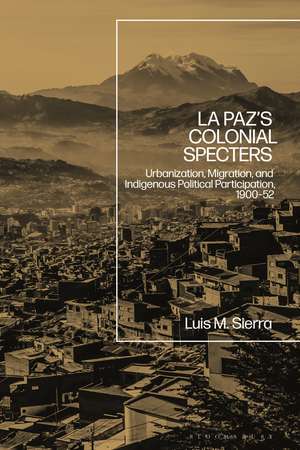La Paz's Colonial Specters: Urbanization, Migration, and Indigenous Political Participation, 1900-52
Autor Assistant Professor Luis Sierraen Limba Engleză Paperback – 27 iul 2022
| Toate formatele și edițiile | Preț | Express |
|---|---|---|
| Paperback (1) | 197.86 lei 6-8 săpt. | |
| Bloomsbury Publishing – 27 iul 2022 | 197.86 lei 6-8 săpt. | |
| Hardback (1) | 471.72 lei 3-5 săpt. | +27.97 lei 4-10 zile |
| Bloomsbury Publishing – 13 ian 2021 | 471.72 lei 3-5 săpt. | +27.97 lei 4-10 zile |
Preț: 197.86 lei
Preț vechi: 257.92 lei
-23% Nou
Puncte Express: 297
Preț estimativ în valută:
37.87€ • 39.12$ • 31.51£
37.87€ • 39.12$ • 31.51£
Carte tipărită la comandă
Livrare economică 25 martie-08 aprilie
Preluare comenzi: 021 569.72.76
Specificații
ISBN-13: 9781350204225
ISBN-10: 1350204226
Pagini: 248
Dimensiuni: 156 x 234 x 18 mm
Greutate: 0.35 kg
Editura: Bloomsbury Publishing
Colecția Bloomsbury Academic
Locul publicării:London, United Kingdom
ISBN-10: 1350204226
Pagini: 248
Dimensiuni: 156 x 234 x 18 mm
Greutate: 0.35 kg
Editura: Bloomsbury Publishing
Colecția Bloomsbury Academic
Locul publicării:London, United Kingdom
Caracteristici
Studies La Paz, a relatively small city, to give new insights into historical processes of urbanization normally reserved for larger urban environments
Notă biografică
Luis M. Sierra is Assistant Professor of History and Director of the Global Initiatives Office at Thomas More College, USA, where he teaches World Civilizations and US History as well as graduate classes in Environmental History, US and Latin American Relations, The History of Modern Sports and Piracy and Black Markets. His research focuses on urbanization and indigenous politics in La Paz, Bolivia.
Cuprins
1. Introduction: Urban Morphology and Development2. Consent of the Governed: Public Space, Private Failings 3. The Work Race Does: Government Discrimination and Discourse4. Alternative Identities: Class and National Identities as Political Projects5. Indígenas and Citizens: Popular Understandings of Race and Nation6. The Indigenous Neighborhoods: Popular Political Activism7. Urban Revolution: The Indigenous Neighborhoods' Roles in the MNR Revolution8. Indigeneity: Obstacle for Revolution and ReformBibliographyIndex
Recenzii
La Paz's Colonial Specters will be important to Bolivianists of many disciplines and to scholars of urbanization generally. It is also a significant contribution to the literature on the various ways that Latin American politicians and intellectuals ... conceptualized and integrated their Indigenous populations.
In La Paz's Colonial Specters, Luis Sierra offers us a bold reimagining of how Bolivia's indigenous advocated and advanced their community interests in the decades before the Chaco War. They pushed back against racism, residential segregation, and other forms of exclusion, and in the process helped paved the way for deeper social transformations that occurred after 1952.
Sierra's analysis is astute, his research is meticulous, and he uses a comparative lens to contextualize the lived experience of race in La Paz. Providing new insights into the popular basis of Bolivia's 1952 revolution, his rich depiction of contestations over urban space shows how a mobilized populace profoundly shaped their society
'Using a blend of urban geography and governmental documentation, Luis Sierra offers an innovative interpretation of La Paz's neighborhoods and the fragile concept of the city as a whole. With an emphasis on the role of urban space, Sierra invites us to rethink dichotomies prevalent in Latin American historiography, such as: rural vs urban, indigenous vs Creole, and state politics vs local political initiatives.'
In La Paz's Colonial Specters, Luis Sierra offers us a bold reimagining of how Bolivia's indigenous advocated and advanced their community interests in the decades before the Chaco War. They pushed back against racism, residential segregation, and other forms of exclusion, and in the process helped paved the way for deeper social transformations that occurred after 1952.
Sierra's analysis is astute, his research is meticulous, and he uses a comparative lens to contextualize the lived experience of race in La Paz. Providing new insights into the popular basis of Bolivia's 1952 revolution, his rich depiction of contestations over urban space shows how a mobilized populace profoundly shaped their society
'Using a blend of urban geography and governmental documentation, Luis Sierra offers an innovative interpretation of La Paz's neighborhoods and the fragile concept of the city as a whole. With an emphasis on the role of urban space, Sierra invites us to rethink dichotomies prevalent in Latin American historiography, such as: rural vs urban, indigenous vs Creole, and state politics vs local political initiatives.'
